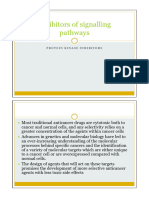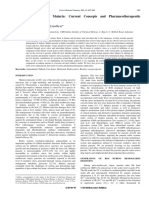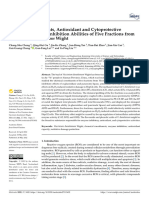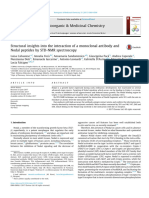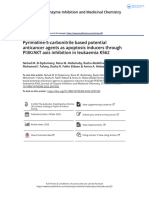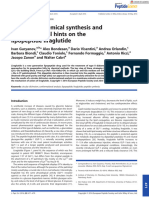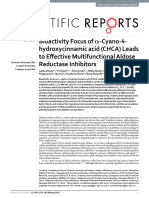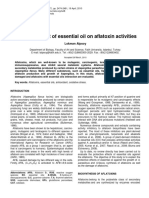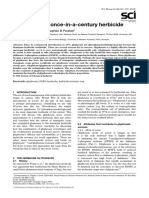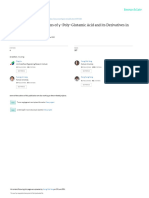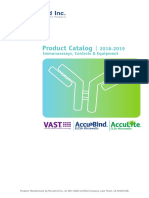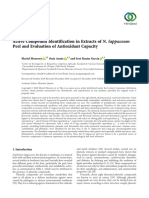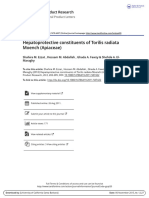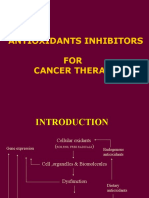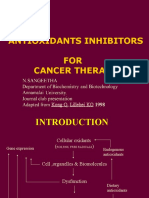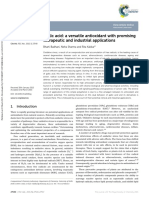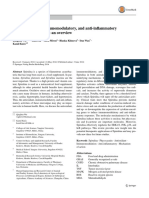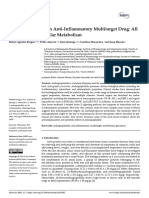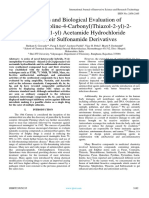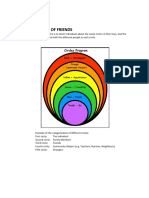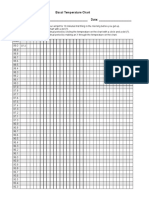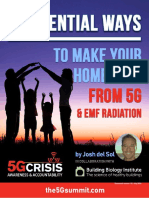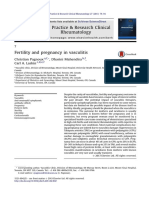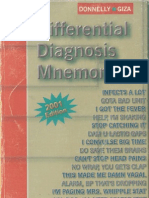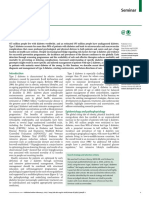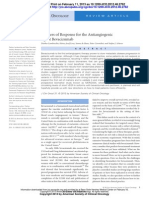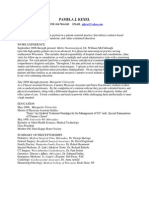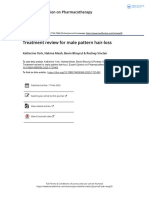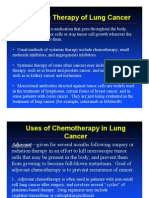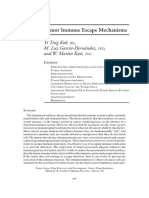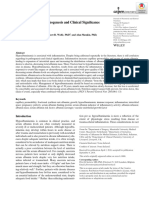IV Therapy Use and Compatibility Chart © Paul S. Anderson 2015 - Prepared For Anderson Medical Group, BCRC and SCRI - All Rights Reserved
IV Therapy Use and Compatibility Chart © Paul S. Anderson 2015 - Prepared For Anderson Medical Group, BCRC and SCRI - All Rights Reserved
Uploaded by
ElenaMatsnevaCopyright:
Available Formats
IV Therapy Use and Compatibility Chart © Paul S. Anderson 2015 - Prepared For Anderson Medical Group, BCRC and SCRI - All Rights Reserved
IV Therapy Use and Compatibility Chart © Paul S. Anderson 2015 - Prepared For Anderson Medical Group, BCRC and SCRI - All Rights Reserved
Uploaded by
ElenaMatsnevaOriginal Title
Copyright
Available Formats
Share this document
Did you find this document useful?
Is this content inappropriate?
Copyright:
Available Formats
IV Therapy Use and Compatibility Chart © Paul S. Anderson 2015 - Prepared For Anderson Medical Group, BCRC and SCRI - All Rights Reserved
IV Therapy Use and Compatibility Chart © Paul S. Anderson 2015 - Prepared For Anderson Medical Group, BCRC and SCRI - All Rights Reserved
Uploaded by
ElenaMatsnevaCopyright:
Available Formats
IV Therapy Use and Compatibility Chart
© Paul S. Anderson 2015 – Prepared for Anderson Medical Group, BCRC* and SCRI* – All rights reserved
Item # Therapy / Agent Potential MOA Compatibility Notes
1 Ascorbate – Low dose Antioxidant, VEGF inhibitor, QOL, Chemo/Rad sensitizer, 4,5,6,7,8,9,10,-19 a, e
2 Ascorbate – High dose Oxidant – ROS Burst, VEGF inhibitor, Chemo/Rad sensitizer, 3,4,5,6,18,19 b
3 Artesunate Oxidant - ROS Burst, Immune modulator (opposes autoimmune TH imbalance) 2,4,5, 19 c, d, e, g
4 DCA Alkylating agent, Metabolism switching – aerobic facilitator, ROS generator 1,2,3,5-18 d
5 Vitamin K Oxidant [K3], Growth and Cell Cycle arrest [K1,2] 1-19 [depending on form] e
6 Germanium Natural Killer Cell function enhancer, TNFg inducer, T-cell inducer, SOD enhancer 1-19 d, f
7 Transition metals Cofactor support 1, 4-19 e, f
8 B-Vitamins Cofactor support 1, 4-19 e, f
9 Glutathione GSH donor, QOL, Chemo sensitization 1, 4-19 d, e
10 ALA GSH support, antioxidant, QOL, GLUT-receptor stimulator, NF(k)B stabilizer, Tumor cell anti- 1, 4-19 d, e
proliferation / Apoptotic agent
11 LAMC [Poly-MVA] GSH / mitochondrial support, Metabolism switching – aerobic facilitator, Apoptotic agent, HIF-1 1, 4-19 d, e
inhibitor, QOL
12 Curcumin Antioxidant, Immune modulator, NF(k)B inhibitor, affects growth factor receptors and cell adhesion 1, 4-19 d
molecules involved in tumor growth, angiogenesis and metastasis
13 Resveratrol Chemo sensitizer, Affects - cell growth, inflammation, apoptosis, angiogenesis, and invasion and 1, 4-19 d
metastasis. Potential as antioxidant and pro-oxidant.
14 Silibinin Hepatic GSH support, Chemo sensitizer, Prevention of chemotherapy induced toxicity, 1, 4-19 d
immunomodulator, QOL
15 Quercetin Antioxidant, antiproliferative and antimutagenic, apoptosis inducer 1, 4-19 d
16 Calcitriol Taxane and Platin enhancer, Apoptotic agent, Antiproliferant, Hedgehog signal inhibitor, cell cycle 1, 4-19 d
arrest, differentiation, angiogenesis and inhibition of cell invasiveness
17 EGCG Chemo preventive, Inhibition of heat shock proteins, Ascorbate synergist (potential) 1, [2?], 4-19 d
18 Phospholipids Lipid exchange, Membrane stabilizer, Acetylcholine primer, etc. 1-20 d, g
19 Silver Hydrosol Disruptor of: Infectious agents & biofilms. Potential oncologic uses 1-3; 5-18 d, g
20 H2O2, Ozone Cytokine stimulant (via ReDox + Enzymatic activity in plasma) PMID: 19260079, 20335512 *h
21 UV Blood Irradiation Multiple MOA - PMID: 6182067, 2631372, 2389276 *i
Notes: a – ‘Low’ dose is considered under 15-20 grams h – Based on MOA, pure oxidative enzymatic agents such as H2O2 + O3 should
be allowed to work on their own for a period of time. The downstream enzymatic cytokine
b – ‘High’ dose is over 15-20 grams but may reach 100-200 grams cascade from these therapies can proceed for hours following administration. In protecting
this cascade and maximizing its effectiveness the recommendation is to have no other IV
c – Generally given directly prior to other oxidant IV’s therapy for 4-6 hours after these IV’s.
d – Compatible in the same time period; not in the same IV bag i – MOA are complicated and not fully elucidated. Based on the available data it
would be reasonable to consider that UVBI could be used in series with most other
e – Compatibility depends on form of vitamin K
therapies. Some data [PMID: 20335512] show that O3 + UV (and possibly O3 alone) do
f – Compatible with water soluble IV formulas speed ascorbate oxidation – so a theoretical benefit may exist in coupling oxidant ascorbate
therapy and UV or UV+O3.
g – Based on multiple MOA may be used in both ReDox environments
All information provided is based on literature review as of 08-2015 and every attempt to ensure accuracy has been made. This information is subject to change as data emerge. The clinician should exert
final judgment prior to implementing any therapy mentioned in this summary. References for all mechanistic statements are contained in the IV Therapy notes presented separately. BCRC – Bastyr Clinical
Research Center; SCRI – Southwest College Research Institute.
You might also like
- BDs Girth Expansion PackDocument124 pagesBDs Girth Expansion Packmrcharliericho100% (9)
- Toxic Cocktail - How Chemical Pollution Is Poisoning Our BrainsDocument273 pagesToxic Cocktail - How Chemical Pollution Is Poisoning Our BrainsElenaMatsneva100% (1)
- PI3K Inhibitors Are Finally Coming of AgeDocument29 pagesPI3K Inhibitors Are Finally Coming of Agedannyutube93No ratings yet
- Fphar 13 1004520Document15 pagesFphar 13 1004520rkreid77No ratings yet
- Lithium On ThyroidDocument13 pagesLithium On Thyroidshaimaa.kashef2020No ratings yet
- 10 1016@j Pharmthera 2020 107521 PDFDocument112 pages10 1016@j Pharmthera 2020 107521 PDFSyedNo ratings yet
- Molecular Biology PresentationDocument22 pagesMolecular Biology Presentationgarimaupadhyay20002No ratings yet
- A Review of AntioxidantsDocument3 pagesA Review of AntioxidantsThuong Lam Huynh HoaiNo ratings yet
- Rahma PGR 2021Document18 pagesRahma PGR 2021Hatem BoubakriNo ratings yet
- Elicitation of PlantsDocument13 pagesElicitation of PlantsFitri SukmawatiNo ratings yet
- Inhibitors of Signalling PathwaysDocument18 pagesInhibitors of Signalling Pathwaysam55eer55No ratings yet
- Goyal 2012Document29 pagesGoyal 2012Andreea StoicaNo ratings yet
- Molecules 27 03432abtsDocument17 pagesMolecules 27 03432abtsgtenienteNo ratings yet
- Structural Insights Into The Interaction of A Monoclonal Antibody and Nodal Peptides by STD-NMR SpectrosDocument8 pagesStructural Insights Into The Interaction of A Monoclonal Antibody and Nodal Peptides by STD-NMR Spectros6gtnsvdw72No ratings yet
- Fonc 12 1003588Document8 pagesFonc 12 1003588sofiaNo ratings yet
- Pyrimidine-5-Carbonitrile Based Potential Anticancer Agents As Apoptosis Inducers Through PI3K AKT Axis Inhibition in Leukaemia K562Document18 pagesPyrimidine-5-Carbonitrile Based Potential Anticancer Agents As Apoptosis Inducers Through PI3K AKT Axis Inhibition in Leukaemia K562Pooja NaikNo ratings yet
- Journal of Peptide Science - 2016 - Guryanov - Innovative chemical synthesis and conformational hints on the lipopeptideDocument9 pagesJournal of Peptide Science - 2016 - Guryanov - Innovative chemical synthesis and conformational hints on the lipopeptideOntores阿No ratings yet
- Nature ReportDocument13 pagesNature ReportDinhtrung TruongNo ratings yet
- ArticuloDocument11 pagesArticuloRoberto Hernandez PosadasNo ratings yet
- ajol-file-journals_82_articles_79702_submission_proof_79702-973-187547-1-10-20120727Document8 pagesajol-file-journals_82_articles_79702_submission_proof_79702-973-187547-1-10-20120727KNNNo ratings yet
- Pengaruh Terapi Ekstrak Teripang Emas Dan Oksigen HiperbarikDocument7 pagesPengaruh Terapi Ekstrak Teripang Emas Dan Oksigen HiperbarikBrilian Sheryna YuvyzaNo ratings yet
- Principles of Genotypic Drug-Susceptibility TestingDocument40 pagesPrinciples of Genotypic Drug-Susceptibility TestingAiko Naomi Vigo TayroNo ratings yet
- Resistant ManagementDocument27 pagesResistant ManagementCocoaSafe-MalaysiaNo ratings yet
- Janus Kinase InhibitorsDocument31 pagesJanus Kinase InhibitorsDr. Pabitra KumarNo ratings yet
- J.Biol - Chem. 2009 Prvral 4936 43Document11 pagesJ.Biol - Chem. 2009 Prvral 4936 43Iza DGNo ratings yet
- Polyphenols Methods of ExtractionDocument6 pagesPolyphenols Methods of ExtractionWidayat WahyuNo ratings yet
- Tocopherols As Antioxidants in Lipid Based Systems The Combination of Chemical and Physicochemical Interactions Determines Their EfficieDocument47 pagesTocopherols As Antioxidants in Lipid Based Systems The Combination of Chemical and Physicochemical Interactions Determines Their EfficieDiego MonterrozaNo ratings yet
- Breimer 2006Document10 pagesBreimer 2006angela_karenina_1No ratings yet
- Journal of Peptide Science - 2024 - Xue - All Hydrocarbon Stapling Enables Improvement of Antimicrobial Activity andDocument9 pagesJournal of Peptide Science - 2024 - Xue - All Hydrocarbon Stapling Enables Improvement of Antimicrobial Activity andwigalel243No ratings yet
- Ruscica 2018Document12 pagesRuscica 2018roshan bhandariNo ratings yet
- Glyphosate A Century HerbicideDocument7 pagesGlyphosate A Century HerbicideGabyMezaCarrascoNo ratings yet
- Biomedical and Therapeutic Applications of Biosurfactants: Chapter #Document14 pagesBiomedical and Therapeutic Applications of Biosurfactants: Chapter #Trainer NIANo ratings yet
- Impact of Multi Micronutrient Supplementation On LDocument9 pagesImpact of Multi Micronutrient Supplementation On LFERNANDA MAGDALENA BASTIAS GONZALEZNo ratings yet
- CPB 1Document9 pagesCPB 1vanessa_werbickyNo ratings yet
- Current Therapies in Alleviating Liver Disorders and Cancers With A Special Focus On The Potential of Vitamin DDocument18 pagesCurrent Therapies in Alleviating Liver Disorders and Cancers With A Special Focus On The Potential of Vitamin DSupermanNo ratings yet
- Novel TGF-B Inhibitors Ready For Prime Time in OncDocument6 pagesNovel TGF-B Inhibitors Ready For Prime Time in OncLEIDY MARIAN MACHADO MANJARREZNo ratings yet
- s41598-023-35228-yDocument13 pagess41598-023-35228-yj.renaudmenangaNo ratings yet
- Metabolic Perturbations Caused by the Over-ExpressDocument13 pagesMetabolic Perturbations Caused by the Over-Expressvakges92No ratings yet
- Monobind Reagent CatalogDocument40 pagesMonobind Reagent Catalogthuy dinhNo ratings yet
- Palozza 2010Document17 pagesPalozza 2010juan.velandiaNo ratings yet
- DE Marco et al 2013Document24 pagesDE Marco et al 2013Juliana MirandaNo ratings yet
- CRF Sorbate and Benzoate ReviewDocument14 pagesCRF Sorbate and Benzoate Reviewaryamanmadan10No ratings yet
- 1998v46no2p401 406Document6 pages1998v46no2p401 406Kabo BakoNo ratings yet
- AktivitasDocument14 pagesAktivitaswisdawisdayanti7No ratings yet
- Ezzat Et Al., 2012Document5 pagesEzzat Et Al., 2012petunia hybridaNo ratings yet
- 10 1016@j Cej 2020 125574Document32 pages10 1016@j Cej 2020 125574Abhijeet MohantyNo ratings yet
- Chitosan and Its Oligosaccharides, A Promising Option For SustainableDocument65 pagesChitosan and Its Oligosaccharides, A Promising Option For SustainableTesfabirhan MiracleNo ratings yet
- Antioxidants in DermatologyDocument7 pagesAntioxidants in DermatologyHendraldy KingNo ratings yet
- Curs VII - Terapii SistemiceDocument229 pagesCurs VII - Terapii SistemiceHucay EduardNo ratings yet
- Antioxidants Inhibitors FOR Cancer TherapyDocument21 pagesAntioxidants Inhibitors FOR Cancer TherapytskumarphdNo ratings yet
- Antioxidants Inhibitors FOR Cancer TherapyDocument21 pagesAntioxidants Inhibitors FOR Cancer TherapynsangeethabioNo ratings yet
- 1-s2.0-S0141813023003628-mainDocument9 pages1-s2.0-S0141813023003628-mainYassin AlamiNo ratings yet
- RSC Advances: ReviewDocument18 pagesRSC Advances: ReviewAndrew LondonNo ratings yet
- loo_1999bDocument13 pagesloo_1999bdenizdarkblueNo ratings yet
- The Antioxidant, Immunomodulatory, and Anti Inflammatory Activities of Spirulina: An OverviewDocument24 pagesThe Antioxidant, Immunomodulatory, and Anti Inflammatory Activities of Spirulina: An OverviewPlacido Rojas FrancoNo ratings yet
- REE15Document40 pagesREE15drdgrant6055No ratings yet
- Molecules 26 00005Document18 pagesMolecules 26 00005elektifppra2022No ratings yet
- Synthesis and Biological Evaluation of N - (4 - (Morpholine-4-Carbonyl) Thiazol-2-Yl) - 2 - (Piperazin-1-Yl) Acetamide Hydrochloride and Their Sulfonamide DerivativesDocument11 pagesSynthesis and Biological Evaluation of N - (4 - (Morpholine-4-Carbonyl) Thiazol-2-Yl) - 2 - (Piperazin-1-Yl) Acetamide Hydrochloride and Their Sulfonamide DerivativesInternational Journal of Innovative Science and Research TechnologyNo ratings yet
- Phytomedicine: Candida Albicans BiofilmsDocument6 pagesPhytomedicine: Candida Albicans BiofilmsVinícius PiantaNo ratings yet
- 1 s2.0 S0968000414002205 MainDocument13 pages1 s2.0 S0968000414002205 MaingordonmosheNo ratings yet
- Medical Applications and Toxicities of Gallium CompoundsDocument25 pagesMedical Applications and Toxicities of Gallium CompoundsPaula GeorgianaNo ratings yet
- What Is Neural Therapy - BiopunctureDocument5 pagesWhat Is Neural Therapy - BiopunctureElenaMatsnevaNo ratings yet
- DR Klinghardt Corona 2020 Slides 9 March 2020 PDFDocument10 pagesDR Klinghardt Corona 2020 Slides 9 March 2020 PDFElenaMatsneva100% (1)
- Circles of FriendsDocument2 pagesCircles of FriendsElenaMatsnevaNo ratings yet
- The Basal Temperature ChartDocument2 pagesThe Basal Temperature ChartElenaMatsnevaNo ratings yet
- The Methylation Cycle and Mental HealthDocument12 pagesThe Methylation Cycle and Mental HealthElenaMatsneva100% (1)
- 7 Essential Ways To Make Your Home SafeDocument19 pages7 Essential Ways To Make Your Home SafeElenaMatsnevaNo ratings yet
- Minimum Supplement Schedule - Basic, Advanced, Prechelation, and ChelationDocument20 pagesMinimum Supplement Schedule - Basic, Advanced, Prechelation, and ChelationElenaMatsnevaNo ratings yet
- Best Practice & Research Clinical Rheumatology: Christian Pagnoux, Dharini Mahendira, Carl A. LaskinDocument16 pagesBest Practice & Research Clinical Rheumatology: Christian Pagnoux, Dharini Mahendira, Carl A. LaskinElenaMatsnevaNo ratings yet
- Drug Herb Interactions PDFDocument549 pagesDrug Herb Interactions PDFKknow Ddrug100% (1)
- High FODMAP Foods: Fruits GrainsDocument3 pagesHigh FODMAP Foods: Fruits GrainsElenaMatsnevaNo ratings yet
- How To Case TakingDocument11 pagesHow To Case TakingElenaMatsnevaNo ratings yet
- Differential Diagnosis MnemonicsDocument283 pagesDifferential Diagnosis Mnemonicstyagee100% (16)
- Type 2 DiabetesDocument13 pagesType 2 DiabetesElenaMatsneva100% (2)
- Bevacizumab MarcadoresDocument13 pagesBevacizumab MarcadoresrbarcellonaNo ratings yet
- Pamela J. Kexel: ObjectiveDocument3 pagesPamela J. Kexel: ObjectiveIlda Dhe Devis SpahoNo ratings yet
- A Review of The Treatment of Male Pattern Hair LossDocument11 pagesA Review of The Treatment of Male Pattern Hair LossigorfragaNo ratings yet
- Gupta Kumar - Nano Meningkatkan BA DLLDocument40 pagesGupta Kumar - Nano Meningkatkan BA DLLHesti HariantiNo ratings yet
- Wound Healing and Its Impairment in The Diabetic Foot: ReviewDocument9 pagesWound Healing and Its Impairment in The Diabetic Foot: ReviewJoey TsaiNo ratings yet
- Evaluation of Anti-Angiogenic Effect of Duck Embryo Chorioallantoic Membrane (CAM) AssayDocument16 pagesEvaluation of Anti-Angiogenic Effect of Duck Embryo Chorioallantoic Membrane (CAM) AssayMerrene Bright Divino JudanNo ratings yet
- The Influence of Leukocyte-Platelet-Rich Plasma On Accelerated Orthodontic Tooth Movement in RabbitsDocument9 pagesThe Influence of Leukocyte-Platelet-Rich Plasma On Accelerated Orthodontic Tooth Movement in RabbitsMustafa AlsultanNo ratings yet
- Anti-VEGF Agents and Their Clinical Applications: Dr. Sriniwas Atal MD. Resident OphthalmologyDocument67 pagesAnti-VEGF Agents and Their Clinical Applications: Dr. Sriniwas Atal MD. Resident OphthalmologySriniwasNo ratings yet
- Hiperbar O2Document22 pagesHiperbar O2Zekany AndreiNo ratings yet
- Rev of Pat and Gen 7 TH EdiDocument707 pagesRev of Pat and Gen 7 TH EdihatsuneNo ratings yet
- Fundamentals of Nursing NCLEX Practice Questions Quiz 2Document41 pagesFundamentals of Nursing NCLEX Practice Questions Quiz 2Regine Mae Encinada100% (1)
- Medical Management of AVN of Head of FemurOur ExperienceDocument4 pagesMedical Management of AVN of Head of FemurOur ExperienceInternational Journal of Innovative Science and Research TechnologyNo ratings yet
- Uch 012784Document10 pagesUch 012784José BernalNo ratings yet
- Blood Flow RegulationDocument30 pagesBlood Flow RegulationEka AlpasraNo ratings yet
- FinalsDocument14 pagesFinalsZarina AvesNo ratings yet
- Journal Pre-Proof: Ceramics InternationalDocument55 pagesJournal Pre-Proof: Ceramics InternationalEliton Medeiros Candido de MacêdoNo ratings yet
- Review On Salvia OfficinalisDocument5 pagesReview On Salvia OfficinalisDevansh Mehta100% (1)
- 1 s2.0 S0378874122007024 MainDocument27 pages1 s2.0 S0378874122007024 MainAmineMohamedNo ratings yet
- A Review of Hydrogen As A New Medical TherapyDocument8 pagesA Review of Hydrogen As A New Medical TherapyfooykokNo ratings yet
- Targeting Tumor Associated Macrophages (TAMs) Via NanocarriersDocument15 pagesTargeting Tumor Associated Macrophages (TAMs) Via Nanocarriersyuvrajsingh3No ratings yet
- Complimentary Alternative Medicine For CANCERDocument107 pagesComplimentary Alternative Medicine For CANCERShiva Shiv100% (1)
- Hyphema. Part IDocument7 pagesHyphema. Part Itaner_soysurenNo ratings yet
- Tumor Immune Escape Mechanisms: Yi Ting Koh,, M. Luz García-Hernández,, and W. Martin KastDocument26 pagesTumor Immune Escape Mechanisms: Yi Ting Koh,, M. Luz García-Hernández,, and W. Martin KastTina HerreraNo ratings yet
- Tissue Renewal and Repair RegenerationDocument13 pagesTissue Renewal and Repair Regenerationمحسن حدوان عليخانNo ratings yet
- Assignment 3 - Clas 120Document9 pagesAssignment 3 - Clas 120KrushangiNo ratings yet
- EAP 6 - Unit 8 - Lesson 3 - Analyzing A Concept PaperDocument44 pagesEAP 6 - Unit 8 - Lesson 3 - Analyzing A Concept PaperCrystal IlaganNo ratings yet
- The Blood Brain and Other Neural Barriers Methods in Molec Bio 0686 S Nag Humana 2011 WWDocument591 pagesThe Blood Brain and Other Neural Barriers Methods in Molec Bio 0686 S Nag Humana 2011 WWAlexandr TrotskyNo ratings yet
- Hypoalbuminemia: Pathogenesis and Clinical SignificanceDocument13 pagesHypoalbuminemia: Pathogenesis and Clinical SignificanceLuna Ivanka Al FatihNo ratings yet
- HSCM 2022 Student Notebook Stream 2 FinalDocument48 pagesHSCM 2022 Student Notebook Stream 2 FinalHANo ratings yet










